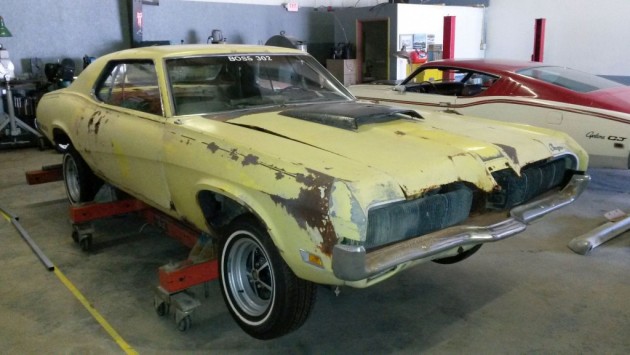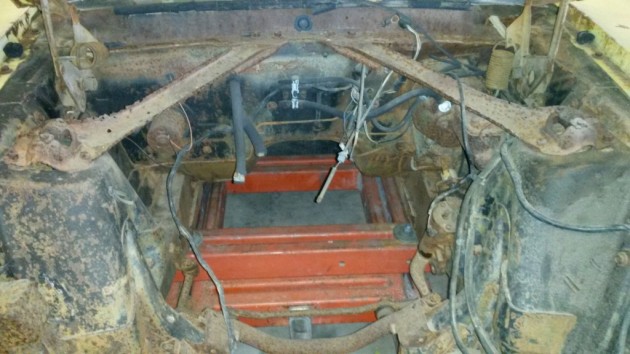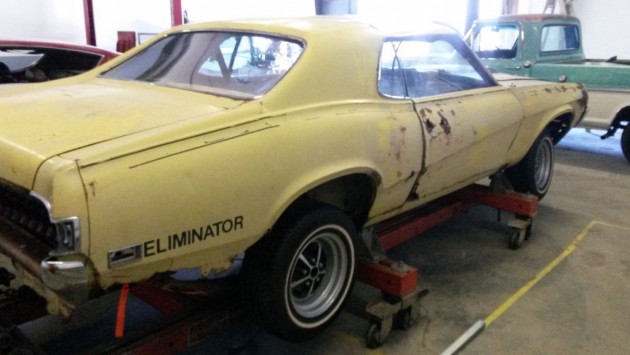When you hear “BOSS 302” you probably picture a Mustang, but Mercury also dropped the race bred engine into their Eliminator. The Cougar offered more luxury than the Mustang and they can be found for slightly less outlay today. Prices seem to be catching up though and with fewer produced, I wouldn’t be surprised if they surpass their Ford brethren soon. There’s no sense in speculating though when taking on a big project like this one found here on eBay though. It’s rusty and missing parts so it will be a gamble even if it goes cheap.
The BOSS 302 engine was created to compete in the SCCA’s Trans-Am race series. To comply with the displacement requirements Ford took a 302 block and stuck 351 heads on it. The resulting powerplant was competitive then and is very desirable today. Unfortunately, the gem of an engine has gone missing here along with its wide ratio transmission.
In case you didn’t already know that you were looking at a BOSS 302 Eliminator, the seller has applied a couple of stickers on the quarters and windshield to remind you. At least the seller is realistic about the rust. Let’s just hope they are realistic about their reserve price too.
Just about every single panel is going to need repaired or replaced here. Personally, I would want to start with something a little more solid and complete, but I can respect the people who are willing and able to save a car like this from the crusher. Do you think you could do the job?






I am in love with the Cyclone CJ, 1969?
This kitty needs a bigger litter box.
Thank God that seller was thoughtful enough to put stickers on the body! I would NEVER have known what kind of car it was.
All Cougar Eliminators had the name on the rear quarters. I am not an expert in that I don’t know if this ELIMINATOR is stock, typically more of an outline lettering than block style. 69’s had it at the front of the quarter coming off the stripe on the door and fender. The 70 had it in this area on the quarter but not sure if style and size of the lettering is right. The windshield sticker, not to sure on that one. Not too many of these out there. Pretty cool cars.
That’s stock
Stock example.
tummy rumblings
The eliminate decals look factory to me. Know of a couple eliminators in this area. Had to actually see where this one was, looks an awful lot like one I know of in Espyville pa.
Hope it gets saved, but that rear quarter looks scary.
As someone that has owned a couple of Cougars (69 CJ, 68 GTE) I can say that the cougar guys are a bit different. They name their cars and constantly complain Cougars don’t bring as much as the same mustang. That said a Boss 302 eliminator is a great muscle car.
Yeah, most of us are a bit different :-) I think it comes from wanting a car that is a bit different too. I wouldn’t say that we constantly complain about Cougar values lagging behind Mustang. I think the largest complaint is the lack of reproduction Cougar parts – although it is much better now than it was in the past. However, sheetmetal is still lacking.
However, NPD now has a Cougar parts catalog, so maybe we’ll see some GOOD sheetmetal being reproduced in the near future!
This one came out of Louisianna in spring / summer 2013, and appeared at a swap meet in TX around the same time. Condition appears largely the same. Decals are not factory.
Interestingly, the original VIN stamped block showed up on eBay in 2009 in KY, in really beat up shape.
I’m a loud proponent for saving this one. Don’t bother restoring it to concours ~ there are better candidates for that. Buy a donor car for sheetmetal, interior and 351C. Then restore it as a driver, or a F.A.S.T / Factory Stock drag car and enjoy the heck out of a true factory Boss 302 Eliminator!
Eliminator group discussion, here: https://www.facebook.com/groups/473220306059769/permalink/909836385731490/
There’s more sheet metal missing on this one than what’s present.. Best of luck to the winner..
We’ve all seen a lot worse than this. For a few bucks and a year in the garage you and a young helper could turn it into a cool cruiser. Floor pans, trunk floors, battery apron area and trunk drop offs are reproduced (if not factory correct). Quarter panel reproductions are poor, but can be used for donor sections, like the lower areas this car needs.
A “Nice” boss 302 Eliminator driver will fetch somewhere in the $30-40k range, depending on the details (of course). So if you can get this one for the right price and do the work yourself, it could work out reasonably well.
Is this one of these cars where the gas tank doubled as the floor of the trunk? I guess saving 3sq’ of sheet metal would build a couple of extra Cougars a week or so.
Yep, Mustangs were the same. You can get a guard if you like, but I think there are bigger things to worry about here.
I guess I am just not smart enough to understand but isn’t the whole point of the
“Boss 302 Eliminator” the POWERTRAIN? Without that it’s basically just another Mercury?!?! So if my humble I ignorance is correct, then without the entire drivetrain, this thing is a rusted out Mercury? I mean, is that thought process correct, close to correct, or do I need to take my opinions and go hide in a dark corner?!
It’s not just any old Mercury because someone with a 302 could restore it and it’d be worth substantially more. It’s still going to take a lot of time and money though.
To the dark corner with ye! :-b
Seriously though, from the factory the Boss 302’s were plagued with piston skirt issues, so many of them received service replacement blocks at some point in thier lives. Finding a Boss 302 car with its factory VIN stamped block seems to be about a 50/50 shot.
Since the original engine type is coded into the VIN of the vehicle, this Cougar is still considered a “Boss 302 Eliminator”, even without the engine. Kind of like how all those Hemi cars are still Hemi’s even though they have a replacement engine.
So in the case of this car, you could swap in a replacement Boss 302 (which is NOT the same as a regular 302) and make it “correct”, but not “numbers matching” (since it won’t have the factory VIN stamp). There is also the possibility of tracking down the original VIN stamped block and reuniting it with the car.
Really, VIN-stamped engines??
I never knew that FoMoCo VIN-stamped ANY of their drive-train parts, only date- (and maybe work shift-) coded them.
Was that done only for ‘racy’ builds such as production Shelbys and Eliminators like this then? If so, learn something new everyday…
VIN stamping of major drivetrain components (engine and transmission) was a Federal requirement starting in 1968. My understanding is it had something to do with anti-theft measures.
Ford usually VIN stamped the engines on a machined pad at the rear left corner of the block (back driver’s side, for us US folks). But it was done by hand, so mistakes happened. Some VINs were hammered in quite clear, some not, and some were illegible, wrong, or missed entirely. Sometimes the Head was stamped instead of the Block (this is the case with my own car and several others I’ve seen).
Boss 302 blocks were stamped on a machined surface at the top center ~ at the back edge of the intake. If you open the hood on a Boss 302 and look down through the gap between the back of the hood and cowl, you should be able to see the VIN stamp. Again, they were done by hand, so clarity and accuracy will vary.
The manual transmissions were usually stamped somewhere along the top edge of the front flange where it bolts to the bellhousing. This surface was rough, so the stamps can be poorly defined. If you are dilligent and lucky, you can sometimes see the stamp by looking down behind the engine.
Automatics (iirc) are stamped on a pad located on the top of the trans casing, and cannot be easily seen with the trans installed (maybe with a borescope, maybe).
These VIN stamps were generally partial stampings, usually only including the year digit, a letter indicating the production plant, and the sequential 6-digit production number. So ideally something like 0F516388, in the case of this car.
On a related note, this Eliminator body should also have VIN stamps on the top of both shock towers ~ either completely or partially concealed by the fenders. Again, clarity and accuracy may vary, but the ones I have seen were all quite clear and concise. Sometimes these are the complete VIN that will match the dash plate, sometimes partial, like the Block stamps I described above.
Relisted on eBay with a $6.7k buy now / best offer.
http://www.ebay.com/itm/172035407588?ul_noapp=true
Nevermind, sold already! “Best Offer Accepted”.